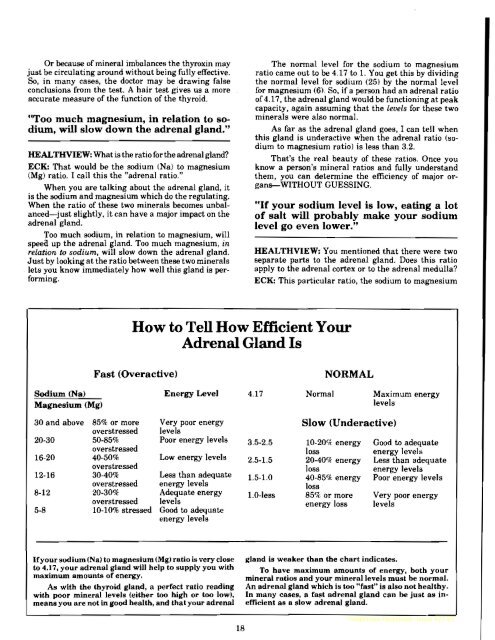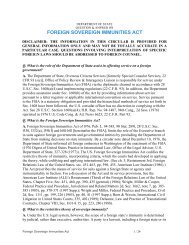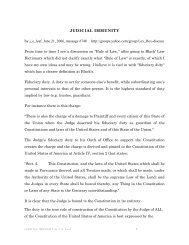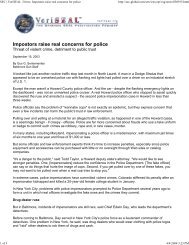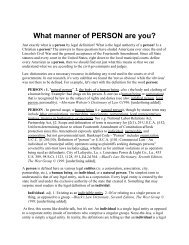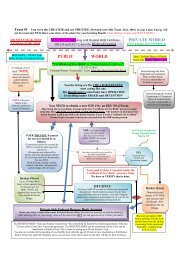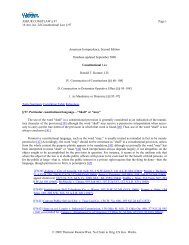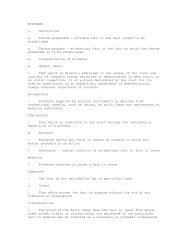The Healthview Newsletter, Issue #27-29 - Freedom School
The Healthview Newsletter, Issue #27-29 - Freedom School
The Healthview Newsletter, Issue #27-29 - Freedom School
You also want an ePaper? Increase the reach of your titles
YUMPU automatically turns print PDFs into web optimized ePapers that Google loves.
Or because of mineral imbalances the thyroxin may<br />
just be circulating around without being fully effective.<br />
So, in many cases, the doctor may be drawing false<br />
conclusions from the test. A hair test gives us a more<br />
accurate measure of the function of the thyroid.<br />
"Too much magnesium, in relation to sodium.<br />
will slow down the adrenal gland."<br />
HEALTHVIEW: What is the ratio for the adrenal gland?<br />
ECK: That would be the sodium (Na) to magnesium<br />
(Mg) ratio. I call this the "adrenal ratio."<br />
When you are talking about the adrenal gland, it<br />
is the sodium and magnesium which do the regulating.<br />
When the ratio of these two minerals becomes unbalanced-just<br />
slightly, it can have a major impact on the<br />
adrenaI gland.<br />
Too much sodium, in relation to magnesium, will<br />
speed up the adrenal gland. Too much magnesium, in<br />
relation to sodium, will slow down the adrenal gland.<br />
Just by looking at the ratio between these two minerals<br />
lets you know immediately how well this gland is per·<br />
forming.<br />
Sodium (Na)<br />
Magnesium (Mgl<br />
How to Tell How Efficient Your<br />
Adrenal Gland Is<br />
Fast (Overactive)<br />
30 and above 85% or more<br />
overstressed<br />
20·30 50·85%<br />
overstressed<br />
16-20 40·50%<br />
overstressed<br />
12·16 30-40%<br />
overstressed<br />
8·12 20.30%<br />
overstressed<br />
5·8 10·10% stressed<br />
Energy Level<br />
Very poor energy<br />
levels<br />
Poor energy levels<br />
Low energy levels<br />
Less than adequate<br />
energy levels<br />
Adequate energy<br />
levels<br />
Good to adequate<br />
energy levels<br />
Ifyour sodium (Na) to magnesium (Mgl ratio is very close<br />
to 4.17, your adrenal gland will help to supply you with<br />
maximum amounts of energy.<br />
A. with the thyroid gland, a perfect ratio reading<br />
with poor mineral levels (either too high or too lowl,<br />
means you are not in good health, and that your adrenal<br />
18<br />
<strong>The</strong> normal level for the sodium to magnesium<br />
ratio came out to be 4.17 to 1. You get this by dividing<br />
the normal level for sodium (25) by the normal level<br />
for magnesium (6). So, if a person had an adrenal ratio<br />
of 4.17, the adrenal gland would be functioning at peak<br />
capacity, again assuming that the levels for these two<br />
minerals were also normal.<br />
As far as the adrenal gland goes, I can tell when<br />
this gland is underactive when the adrenal ratio (so·<br />
dium to magnesium ratio) is less than 3.2.<br />
That's the real beauty of these ratios. Once you<br />
know a person's mineral ratios and fully understand<br />
them, you can determine the efficiency of major or·<br />
gana-WITHOUT GUESSING.<br />
"If your sodium level is low, eating a lot<br />
of salt will probably make your sodium<br />
level go even lower."<br />
HEALTHVIEW: You mentioned that there were two<br />
separate parts to the adrenal gland. Does this ratio<br />
apply to the adrenal cortex or to the adrenal medulla?<br />
ECK: This particular ratio, the sodium to magnesium<br />
NORMAL<br />
4.17 Normal Maximum energy<br />
levels<br />
3.5-2.5<br />
2.5·1.5<br />
1.5·1.0<br />
1.0·le8s<br />
Slow (Underactive)<br />
10·20'k energy<br />
loss<br />
20·40


